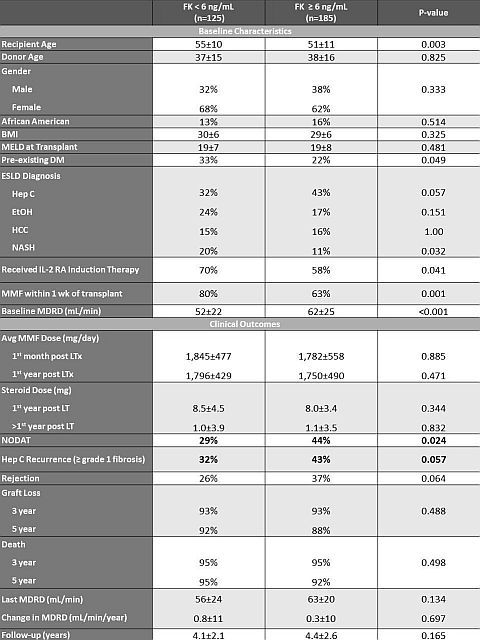Elevated Tacrolimus Trough Concentrations Significantly Increase the Risk of New Onset Diabetes after Liver Transplantation
Transplant Surgery, Medical University of South Carolina, Charleston, SC
Meeting: 2013 American Transplant Congress
Abstract number: D1606
Background: Tacrolimus (FK) is the most common CNI used following liver transplantation (LTx). FK is highly effective at preventing rejection, but is associated with numerous severe toxicities, particularly new onset diabetes (NODAT). The aim of this study was to determine whether FK trough concentrations affect the incidence of NODAT and other outcomes following LTx.
Methods: This was a retrospective analysis of patients who received tacrolimus as part of their immunosuppression regimen following LTx at our center from 2004 to 2011. Pediatric recipients, recipients of multi-organ transplants, and those with graft loss within the first year were excluded. For this analysis patients were grouped by whether their average tacrolimus trough concentration was greater than or less than 6 ng/mL.
Results: Baseline characteristics and clinical outcomes for the 310 included patients are shown in Table 1. At baseline, patients in the FK ≥ 6 ng/mL group were younger, had better renal function, and were less likely to have a diagnosis of NASH or receive induction or MMF. At last follow-up, the patients with average FK ≥ 6 ng/mL had a significantly higher incidence of NODAT, and a trend towards higher rates of HCV recurrence. At end of follow-up, there were no significant differences in acute rejection, graft loss, mortality or renal function.
Table 1 – Baseline Characteristics and Clinical Outcomes.

Conclusion: Average tacrolimus trough concentrations ≥ 6 ng/mL appear to significantly influence the incidence of NODAT and potentially HCV recurrence in LTx recipients. Additionally, higher FK concentrations may prevent improvements in renal function after LTx. Future prospective studies are warranted to determine if employing strategies to minimize FK concentrations after transplant can minimize toxicities while maintaining efficacy.
To cite this abstract in AMA style:
Amarnath R, Taber D, Pilch N, Meadows H, Fleming J, Mardis A, Morbitzer K, Jordan C, Makowski C, Bratton C, McGillicuddy J, Baliga P, Chavin K. Elevated Tacrolimus Trough Concentrations Significantly Increase the Risk of New Onset Diabetes after Liver Transplantation [abstract]. Am J Transplant. 2013; 13 (suppl 5). https://atcmeetingabstracts.com/abstract/elevated-tacrolimus-trough-concentrations-significantly-increase-the-risk-of-new-onset-diabetes-after-liver-transplantation/. Accessed December 22, 2025.« Back to 2013 American Transplant Congress
